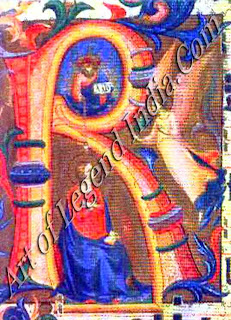 The Work of an Angel
The Work of an Angel
It is
tempting to attribute the stunning beauty of Fra Angelico's work to divine
inspiration, but that would be largely to disregard his abilities and
self-discipline as a highly skilled artist.
The
great Victorian art critic John Ruskin summed up the traditional view of Fra
Angelico when he wrote that he was 'not an artist properly so-called but an
inspired saint'. Fra Angelico was certainly pious, but Ruskin was totally
misleading in suggesting that he was anything other than a highly professional
artist. He was not only in the vanguard of ideas, but also ran an efficient
workshop and travelled considerable distances (to Rome and Orvieto) to take up
commissions. There were several other painter-monks who achieved great
distinction during the Renaissance his contemporaries Lorenzo Monaco and
Filippo Lippi, and two generations later Fra Bartolommeo, who worked at Fra
Angelico's monastery of San Marco. None of them, however, has matched the
popular appeal of Fra Angelico, whose great achievement was in combining the
highest technical skills with a sense of radiant spirituality.
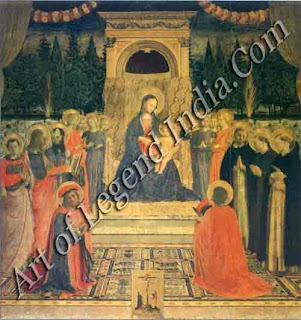 Certain
features of Angelico's style show through virtually all his work, especially
his decorative sense and wonderful skill with colour, but his art developed
greatly during his career, which falls into three broad phases. In the first he
appears as an artist of tremendous innate talent, but still working largely
within traditional conventions. In the second phase, his work takes on a
greater clarity and weight as he absorbs and refines the ideas of his great
contemporaries. And in the third, he excels as a fresco decorator.
Certain
features of Angelico's style show through virtually all his work, especially
his decorative sense and wonderful skill with colour, but his art developed
greatly during his career, which falls into three broad phases. In the first he
appears as an artist of tremendous innate talent, but still working largely
within traditional conventions. In the second phase, his work takes on a
greater clarity and weight as he absorbs and refines the ideas of his great
contemporaries. And in the third, he excels as a fresco decorator.
JEWEL-LIKE WORKS
Angelico's
earliest works, small and jewel-like, are the sort of painting for which the
initial commissioning contract would specify the amount of gold or expensive
blue pigment the painter was required to use. They were intended to decorate
the altars of chapels at Fiesole and in other Dominican establishments. Fra
Angelico was also involved in work on manuscript illumination at this time, an
activity much favoured as a part of the devotional observance of a young friar.
The gorgeous Cortona Annunciation marks the culmination of this early phase but
also in the insistent perspective of the architecture looks forward to his more
naturalistic later style.
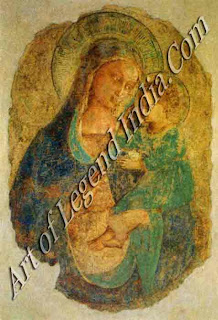
A key
work in his development is the Linaiuoli Altarpiece, the celebrated work
produced for the Florentine Linen Guild in 1433. The magnificent frame is by
Lorenzo Ghiberti, the most famous sculptor of the day, and it pulls together
the various panels Fra Angelico painted and makes them into a coherent whole.
When the altarpiece's doors are shut, two solid, monumental saints (Mark and
Peter) stand next to each other on a firm platform of rocky ground. When they
are open, Saints John the Baptist and John the Evangelist flank the Virgin and
Child, witnesses and guards. Beneath them all, three small panels, known as the
'predella', contain self-contained scenes showing St Peter Preaching, The
Adoration of the Magi and The Martyrdom of St John the Evangelist. Each is a
superbly imaginative interpretation of how the real events may have looked.
Only the angels decorating the painted arch framing the Virgin and Child panel
seem to belong to the earlier, more archaic phase of the painter's work.
THE RENAISSANCE INFLUENCE
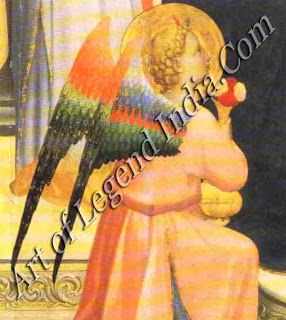 Fra
Angelico did not stumble on this Re-naissance clarity overnight. His earlier
works all show some influence of Renaissance ideas unified lighting,
naturalistic plants and other details, real weight to the fall of the draperies
of the saints' clothing and, most significantly, a scientific use of geometric
perspective to create an illusion of depth in the picture. But in the Linaiuoli
Altarpiece, and other works of the 1430s such as The Deposition from the Cross
painted for Santa Trinita in Florence, they become his guiding principles.
Fra
Angelico did not stumble on this Re-naissance clarity overnight. His earlier
works all show some influence of Renaissance ideas unified lighting,
naturalistic plants and other details, real weight to the fall of the draperies
of the saints' clothing and, most significantly, a scientific use of geometric
perspective to create an illusion of depth in the picture. But in the Linaiuoli
Altarpiece, and other works of the 1430s such as The Deposition from the Cross
painted for Santa Trinita in Florence, they become his guiding principles.
For all
the beauty and splendour of his panel paintings, it is on his frescoes that Fra
Angelico's fame and popularity mainly rests. The art of fresco painting was
more highly developed in Italy than in any other country and for centuries was
regarded as the only fitting outlet for an artist's grandest thoughts. Italy's
bright light means that churches there (compared with those in northern Europe)
tend to have small windows and consequently large areas of wall that can be
covered with paintings. And Italy's generally dry climate is ideal for
preserving frescoes, which can deteriorate rapidly if the walls on which they
are painted become damp.
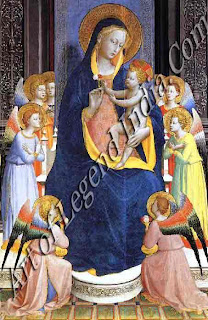
The
sheer scale of the demands placed on Fra Angelico required him to work with a
considerable team for his fresco cycles. First the wall would have to be
carefully plastered, ready to take the master's design. Over this, a top layer
of fine wet plaster was applied, just enough to be painted in one day. The work
would then have to be quick and accurate in order to be completed before the
plaster dried and could no longer take up the paint. Remarkably, a few of Fra Angelico's
own under drawings or sinopie have been uncovered during the restoration of his
frescoes in San Marco and at Fiesole. With the top layer of painted plaster
removed and mounted on a new base, we can see the extraordinary drawings that
lay beneath. This was the clarity of vision that enabled him to carry out large
and complex schemes with numerous assistants, yet still ensure that the works
were his own. When he went to Rome to work for Pope Nicholas V he took a whole
team of assistants, the most important being Benozzo Gozzoli, but stamped his
own artistic personality on the work.
Fra
Angelico lived at a time when the role of art was changing to something to be
appreciated for itself rather than solely for its religious meaning or
decorative function. His work showed that the human messages of the Renaissance
could be charged with the fervour of Catholic Christianity. Indeed, he
succeeded like no other painter of the Renaissance, or any other period, in
creating a synthesis between piety and grandeur.
Writer – Marshall
Cavendish
 Certain
features of Angelico's style show through virtually all his work, especially
his decorative sense and wonderful skill with colour, but his art developed
greatly during his career, which falls into three broad phases. In the first he
appears as an artist of tremendous innate talent, but still working largely
within traditional conventions. In the second phase, his work takes on a
greater clarity and weight as he absorbs and refines the ideas of his great
contemporaries. And in the third, he excels as a fresco decorator.
Certain
features of Angelico's style show through virtually all his work, especially
his decorative sense and wonderful skill with colour, but his art developed
greatly during his career, which falls into three broad phases. In the first he
appears as an artist of tremendous innate talent, but still working largely
within traditional conventions. In the second phase, his work takes on a
greater clarity and weight as he absorbs and refines the ideas of his great
contemporaries. And in the third, he excels as a fresco decorator.  Fra
Angelico did not stumble on this Re-naissance clarity overnight. His earlier
works all show some influence of Renaissance ideas unified lighting,
naturalistic plants and other details, real weight to the fall of the draperies
of the saints' clothing and, most significantly, a scientific use of geometric
perspective to create an illusion of depth in the picture. But in the Linaiuoli
Altarpiece, and other works of the 1430s such as The Deposition from the Cross
painted for Santa Trinita in Florence, they become his guiding principles.
Fra
Angelico did not stumble on this Re-naissance clarity overnight. His earlier
works all show some influence of Renaissance ideas unified lighting,
naturalistic plants and other details, real weight to the fall of the draperies
of the saints' clothing and, most significantly, a scientific use of geometric
perspective to create an illusion of depth in the picture. But in the Linaiuoli
Altarpiece, and other works of the 1430s such as The Deposition from the Cross
painted for Santa Trinita in Florence, they become his guiding principles. 













0 Response to "Italian Great Artist Fra Angelico - The Work of an Angel "
Post a Comment